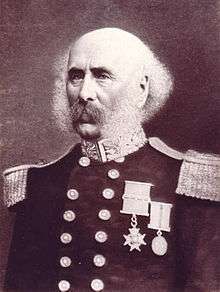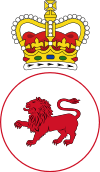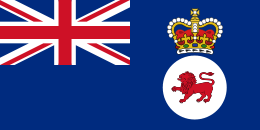Thomas Gore Browne
| Colonel Sir Thomas Robert Gore Browne KCMG, CB | |
|---|---|
 | |
| Governor of Saint Helena | |
|
In office 18 July 1851 – 15 December 1854 | |
| Monarch | Victoria |
| Preceded by | Patrick Ross |
| Succeeded by | Edward Hay Drummond Hay |
| 4th Governor of New Zealand | |
|
In office 6 September 1855 – 3 October 1861 | |
| Monarch | Victoria |
| Premier |
Henry Sewell William Fox Edward Stafford |
| Preceded by | Sir George Grey |
| Succeeded by | Sir George Grey |
| 2nd Governor of Tasmania | |
|
In office 11 December 1861 – 30 December 1868 | |
| Preceded by | Sir Henry Young |
| Succeeded by | Charles Du Cane |
| Personal details | |
| Born |
3 July 1807 Aylesbury, Buckinghamshire, England, UK |
| Died |
17 April 1887 (aged 79) London, England, UK |
| Nationality | British |
Colonel Sir Thomas Robert Gore Browne KCMG CB (3 July 1807 – 17 April 1887) was a British colonial administrator, who was Governor of St Helena, Governor of New Zealand, Governor of Tasmania and Governor of Bermuda.
Early life
Browne was born in Aylesbury, Buckinghamshire, England, the first son of Robert Browne of Morton House, in Buckinghamshire, and of Sarah Dorothea Steward; his younger brother was Harold Browne (later Bishop of Winchester.) He served with the British Army in Afghanistan and India. In 1824 he purchased an Ensigncy in the 44th Foot, but three months later exchanged into the 28th Foot. In 1829 he purchased a Captaincy. In 1836, as a Major, he exchanged into the 41st Foot. In 1842 he was promoted Lieutenant-Colonel in the Army, in 1845 he purchased the Lieutenant-Colonelcy of the 41st Foot, and in 1849 he exchanged into the 21st Foot. He was Governor of St Helena from July 1851 to December 1854.[1] He was promoted Lieutenant-Colonel in the Army in 1854, by which time he was back in his original regiment, the 44th Foot. In 1857, he exchanged from the 14th Foot to the Lieutenant-Colonelcy of the 43rd Foot.
Governor of New Zealand
In September 1855, he was appointed Governor of New Zealand, replacing temporary Administrator Robert Wynyard. His handling of Māori land issues were a contributing factor in the outbreak of the First Taranaki War: despite divisions among Waitara Maori over the ownership of land, Browne persisted with the purchase of the disputed Pekapeka block, further inflaming tensions between Maori and English settlers.[2]
On 5 March 1860, Browne ordered the military occupation of the land, leading to the outbreak of war twelve days later.
The town of Gore, New Zealand was named after him.[3]
Governor of Tasmania
From 1861 until 1868 he was Governor of Tasmania. He was promoted Colonel in the Army in 1864.[4]
Administrator of Bermuda
From September 1870 to April 1871, he was Administrator of Bermuda. He died in London on 17 April 1887.[2]
Family
He married Harriet, daughter of James Campbell of Craigie, Ayrshire, who survived him. They had several children. The eldest son, Harold, commanded the first battalion king's royal rifle corps in the Boer war of 1899-1900, and took part in the defence of Ladysmith.[2] His daughter Ethel married Hugh Locke King, they built the Brooklands motor racing circuit on estate they farmed. His youngest son, Wilfrid was the first Bishop of Kimberley and Kuruman in South Africa. ,
See also
Notes
- ↑ http://sainthelenaisland.info/governor.htm
- 1 2 3
 This article incorporates text from a publication now in the public domain: Lloyd, Ernest Marsh (1901). "Browne, Thomas Gore". In Sidney Lee. Dictionary of National Biography, 1901 supplement. London: Smith, Elder & Co.
This article incorporates text from a publication now in the public domain: Lloyd, Ernest Marsh (1901). "Browne, Thomas Gore". In Sidney Lee. Dictionary of National Biography, 1901 supplement. London: Smith, Elder & Co. - ↑ "District Information". Gore District, New Zealand. Retrieved 4 July 2015.
- ↑ Amos, Helen M. (1969). "Browne, Sir Thomas Gore (1807–1887)". Australian Dictionary of Biography. Canberra: Australian National University. Retrieved 3 May 2008.
External links
| Government offices | ||
|---|---|---|
| Preceded by Patrick Ross |
Governor of Saint Helena 1851–1855 |
Succeeded by Edward Hay Drummond Hay |
| Preceded by Sir George Grey |
Governor of New Zealand 1855–1861 |
Succeeded by Sir George Grey |
| Preceded by Sir Henry Young |
Governor of Tasmania 1862–1868 |
Succeeded by Charles Du Cane |


